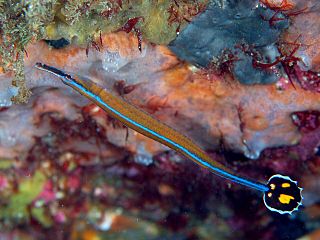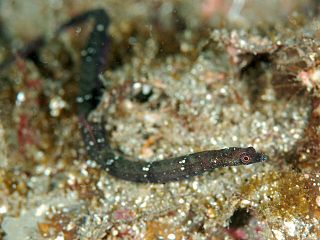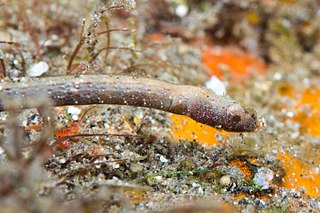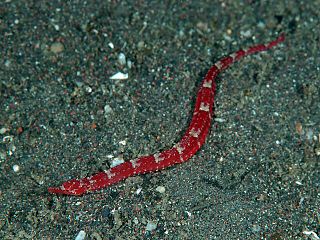
The Syngnathidae is a family of fish which includes seahorses, pipefishes, and seadragons. The name is derived from Greek, σύν (syn), meaning "together", and γνάθος (gnathos), meaning "jaw". This fused jaw trait is something the entire family has in common.

Pipefishes or pipe-fishes (Syngnathinae) are a subfamily of small fishes, which, together with the seahorses and seadragons, form the family Syngnathidae.

Syngnathus is a genus of fish in the family Syngnathidae found in marine, brackish and sometimes fresh waters of the Atlantic, Indian and Pacific Ocean. Fossils of these species are found from the Oligocene to the Pleistocene. They are known from various localities of Greece, Italy, Germany and United States.

Doryrhamphus and Dunckerocampus, popularly known as flagtail pipefish, are two genera of fishes in the family Syngnathidae. They are found in warm, relatively shallow waters of the Indo-Pacific, with a single species, D. paulus, in the eastern Pacific. Most of these pipefishes are very colourful, and are fairly popular in the marine aquarium hobby despite requiring special care and not being recommended for beginners.

Melanotaenia is a genus of rainbowfish from Australia, Indonesia, New Guinea, and nearby smaller islands.

Corythoichthys is a genus of pipefishes of the family Syngnathidae. All species in the genus are found in the tropical Indian and Pacific Oceans on reefs or rubble bottoms. Relationships and taxonomy within the genus are still in debate, but there may be at least 23 species.

Schultz's pipefish, Corythoichthys schultzi, is a pipefish of the family Syngnathidae.

Paracheilinus is a genus of flasher wrasses, native to the Indian Ocean and the western Pacific Ocean.

Halicampus is a genus of pipefishes of the family Syngnathidae, containing 12 described species.
Navigobius is a genus of fish in the family Microdesmidae native to the Indo-Pacific Ocean.

Halicampus dunckeri or also commonly known as the Duncker's pipefish or ridgenose pipefish is a species of fish in the family Syngnathidae.
Festucalex cinctus is a species of marine fish of the pipefish family Syngnathidae which is endemic to the waters off eastern Australia.

The red pipefish is a species of marine pipefish of the family Syngnathidae. It is found throughout the Indo-Pacific, from Mozambique and South Africa to Hawaii, Honshu (Japan), and New Caledonia. It lives among rubble and coral or rocky reefs at depths of 18–40 metres (59–131 ft), where they can grow to lengths of 10 centimetres (3.9 in). They are expected to feed on small crustaceans, such as gammarid shrimps, mysids, and harpacticoid copepods. This species is ovoviviparous, with males brooding eggs and giving birth to live young. Males may brood at lengths of around 5.5 centimetres (2.2 in). It is exported from Hawaii as part of the aquarium trade.
Gibbs’ pipefish is a species of marine fish of the family Syngnathidae. It is found in the Western Pacific, from the Great Barrier Reef to Palau, the Chesterfield Islands and New Caledonia. Unconfirmed specimens have been reported off of the Seychelles in the Indian Ocean. It lives in coastal sandy or rubble habitats, as well as areas with sponges and coralline algae, where it can grow to lengths of 8 centimetres (3.1 in). It is expected to feed on small crustaceans, similar to other pipefish. This species is ovoviviparous, with males brooding eggs and giving birth to live young. Males may brood at lengths of around 5 centimetres (2.0 in). The specific name honours P. E. Gibbs, who collected the type material.
The pink pipefish is a species of coastal pipefish of the family Syngnathidae. It has been found in the East Cape area of Milne Bay, Papua New Guinea, as well as the Solomon Islands, Bali, and Seram Island. It lives in sponges on coral reef slopes at depths of 10–25 metres (33–82 ft), where it can grow to lengths generally less that 4 centimetres (1.6 in). They are found solitary or in pairs, always on an unidentified red tubular sponge which provides them with camouflage. They are expected to feed on small crustaceans, similar to other pipefish. This species is ovoviviparous, with males brooding eggs and giving birth to live young.
Wass's pipefish is a species of marine fish of the family Syngnathidae. It is known from only six species, which were found in the coastal waters of Papua New Guinea, New Caledonia, Fiji, and Samoa. It inhabits soft coral habitats and coral rubble to depths of 50 metres (160 ft), where it can grow to lengths of 7.4 centimetres (2.9 in). Little is known of the species’ feeding habits, but it is expected to eat small crustaceans, similar to other pipefish. This species is ovoviviparous, with males carrying eggs and giving birth to live young. The specific name honours the U.S. Fish & Wildlife Service biologist Richard C. Wass.
Lissocampus fatiloquus, also known as prophet's pipefish is a species of marine fish belonging to the family Syngnathidae. The species has been noted in a variety of habitats including sargassum, seagrass beds and sandy substrates along the coast of Western Australia from Shark Bay to Rottnest Island. Their diet is thought to consist of small crustaceans such as copepods. Reproduction occurs through ovoviviparity in which the males brood eggs before giving live birth.
Stigmatopora nigra, also known as the wide-bodied pipefish is a species of marine fish belonging to the family Syngnathidae. This species can be found in the shallow waters, bays, and estuaries of southern Australia from Shark Bay to Brisbane, Tasmania, and New Zealand. They often inhabit seagrass or algae beds in addition to bare sand. Their diet consists of small crustaceans such as copepods and amphipods. Adult brooding males have been measured at 6.5-7 centimeters. Reproduction occurs through ovoviviparity. in which the males brood up to 25 eggs in a pouch below the tail before giving live birth. Stigmatopora nigra can live to 150 days old and are able to reproduce throughout the year.

Trachyrhamphus bicoarctatus, also known as the double-ended pipefish is a species of marine fish belonging to the family Syngnathidae. They can be found in reefs, seagrass beds, and sandy habitats throughout the Indo-Pacific from East Africa to New Caledonia and from Japan to Australia. Males of this species are considered mature when they reach approximately 26 centimeters long, but adults can grow to be lengths of 40 centimeters. Reproduction occurs through ovoviviparity in which males brood eggs before giving live birth.
Trachyrhamphus longirostris, also known as the long-head pipefish or straightstick pipefish, is a species of marine fish belonging to the family Syngnathidae. They can be found in muddy estuaries on the continental shelf throughout the Indo-Pacific from Eastern Africa to the Solomon Islands and Japan. The diet of Trachyrhamphus longirostris likely consists of small crustaceans. Adult individuals can grow to be approximately 33 centimeters in length. Reproduction occurs through ovoviviparity in which males brood eggs before giving live birth.










